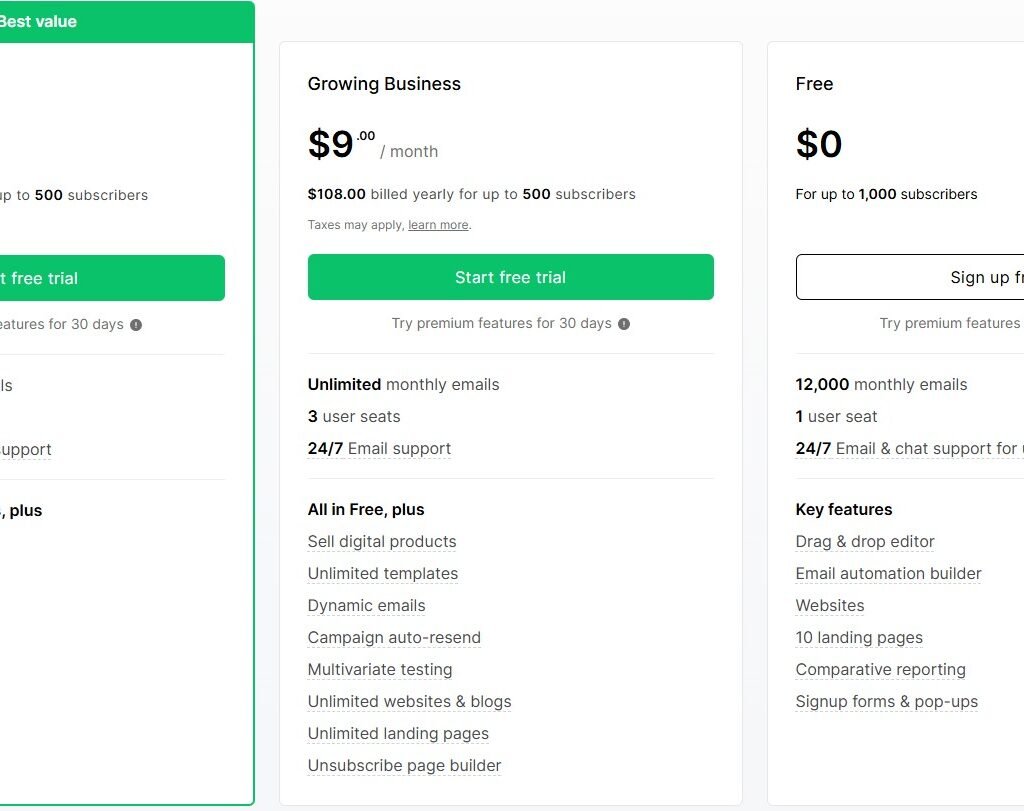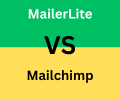This post will unpack practical MailerLite vs Mailchimp techniques to help you achieve more with less stress. From prioritizing deep work to setting guilt-free boundaries, you’ll learn how to align your efforts with what truly matters. Ready to transform the way you work? Let’s begin.
- Pricing & Plans
- Ease of Use & Interface
- Email Marketing Features Showdown
- Automation Features
- List Management & Segmentation
- Deliverability Rates
- A/B Testing & Analytics
- Integrations & Third-Party Apps
- Customer Support
- Landing Pages & Pop-Ups
- Pros & Cons Summary
- Conclusion Final Verdict: Which One Should You Choose?
Pricing & Plans
When deciding between MailerLite vs Mailchimp, pricing is often the most important factor for businesses. Both platforms offer free and paid options, but their pricing models differ significantly. Here’s a clear breakdown to help you choose the best email marketing solution for your budget.
Free Plan Showdown
- MailerLite Free Plan
✔ Up to 1,000 subscribers
✔ Includes email automation
✔ Free landing pages & pop-ups
✔ Basic analytics - Mailchimp Free Plan
✔ Up to 500 subscribers
✖ No automation (paid plans only)
✖ Limited templates
✔ Basic email sending
Paid Plans Comparison

MailerLite Pricing (All-inclusive):
- Starts at $10/month for 1,000 subs
- $30/month for 5,000 subs
- $50/month for 10,000 subs
Includes all features at every tier
Mailchimp Pricing (Tiered System):
- Essentials: $13/month (1,000 subs)
- Standard: $20/month (500 subs)
- Premium: $350/month (10,000 subs)
Advanced features require higher plans
Visual Recommendation:
▶ Insert pricing table comparing 1K/5K/10K subscriber costs
▶ Screenshot of MailerLite’s simple pricing page
▶ Image of Mailchimp’s plan selection interface
Key Pricing Differences
- MailerLite offers one straightforward plan with all features
- Mailchimp uses a complex tiered system with frequent upsells
- Mailchimp charges extra for:
- Email validation ($0.03/email)
- Advanced analytics
- Phone support
Best Choice For:
💰 Budget-conscious users: MailerLite
🛠 Enterprise needs: Mailchimp (if budget allows)
Bottom Line: For most small businesses, MailerLite vs Mailchimp delivers better value with transparent pricing. Mailchimp becomes cost-effective only for large lists needing advanced CRM features.
Pro Tip: Always calculate your potential costs at both services before committing, as prices can jump significantly as your list grows.
Ease of Use & Interface
Email Marketing Features Showdown
When comparing MailerLite vs Mailchimp, core features determine which platform truly delivers for your campaigns. Here’s a direct, no-fluff comparison of their email marketing capabilities:
1. Email Template Design & Editor
- MailerLite:
✔ Intuitive drag-and-drop builder
✔ 100+ responsive templates
✔ Custom HTML/CSS access - Mailchimp:
✔ Advanced designer with more granular control
✔ 300+ templates (premium designs locked)
✔ AI-powered “Creative Assistant”
Winner: Mailchimp for design flexibility; MailerLite for simplicity.
Image Tip: Show side-by-side editor interfaces highlighting complexity vs ease-of-use.
2. Automation Workflows
- MailerLite:
✔ Visual workflow builder
✔ Pre-built templates (welcome, birthday, re-engagement)
✔ Unlimited automation on all plans - Mailchimp:
✔ Complex multi-path automations
✔ Behavioral triggers (e.g., site visits)
✖ Free plan excludes automation
Winner: MailerLite for affordability; Mailchimp for depth (paid plans).
Image Tip: Screenshot a workflow comparison (Mailchimp’s branching vs MailerLite’s simplicity).

3. Segmentation & Targeting
- MailerLite:
✔ Rule-based groups (tags, activity, fields)
✔ Dynamic content blocks - Mailchimp:
✔ Predictive segmentation (AI)
✔ Hyper-specific filters (e.g., “opened X email but didn’t click Y link”)
Winner: Mailchimp for advanced users; MailerLite for essential needs.
4. A/B Testing & Analytics
| Feature | MailerLite | Mailchimp |
|---|---|---|
| A/B Testing | Subject lines only | Subject lines, content, send times |
| Analytics | Open/click rates, geography | Revenue tracking, heatmaps, social media |
| Winner: Mailchimp (more data-driven insights). | ||
| Image Tip: Embed a comparison table + analytics dashboard screenshots. |
5. Unique Standout Features
- MailerLite:
✔ Built-in landing pages (no extra cost)
✔ Surveys & polls in emails - Mailchimp:
✔ AI content generator (“Email Genie”)
✔ Native e-commerce cart recovery
Key Takeaway
💡 Choose MailerLite if you need affordable, all-in-one essentials.
💡 Choose Mailchimp if you require advanced AI, e-commerce, or granular data.
Image Recommendations:
- Header graphic: Split-screen “MailerLite vs Mailchimp Features Battle” visual.
- Mobile renderings: Show how templates look on devices (both platforms).
- Automation screenshots: Contrast Mailchimp’s complexity with MailerLite’s clean UI.
Bottom Line: MailerLite covers 90% of needs for most businesses at lower cost. Mailchimp justifies its price for enterprises needing deep analytics and AI tools. MailerLite vs Mailchimp
Next: We’ll compare deliverability rates →
Need more feature details? Want me to add integrations or GDPR compliance?
Automation Features
List Management & Segmentation
Deliverability Rates
A/B Testing & Analytics
Integrations & Third-Party Apps
Customer Support
Landing Pages & Pop-Ups
Pros & Cons Summary
Conclusion Final Verdict: Which One Should You Choose?
In this post, we’ve explored [briefly recap key points, e.g., “the importance of mindful productivity, MailerLite vs Mailchimpthe strategies to avoid burnout, and the power of small, consistent habits”]. Whether you’re looking to [restate the main goal, e.g., “work smarter, not harder”] or simply [another benefit, e.g., “find more balance in your daily routine”], the key takeaway is that [summarize the core message in one sentence].
Change doesn’t happen overnight, but with the right mindset and tools, MailerLite vs Mailchimp you can [reiterate the desired outcome, e.g., “transform your productivity and reclaim your time”]. Start small, stay consistent, and remember—[end with an encouraging or motivational note, e.g., “progress is always better than perfection”].

 Cart is empty
Cart is empty